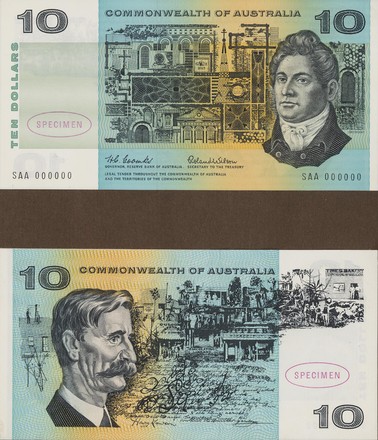Australian Notes: the change to Decimal Currency
Australian Notes: the change to Decimal Currency by Gordon Andrews, 1966
Reserve Bank of
Australia, Sydney
Q655.318/1A1
Acquired 28
January 1966
MAKING NEW MONEY: 50th ANNIVERSARY OF DECIMAL CURRENCY
In April 1963
the Federal Treasurer announced that Australia would adopt decimal currency. Public
opinion determined the new currency would be named the ‘dollar’ with denominations
of $1, $2, $10 and $20 to be created for the changeover on 14 February 1966. Four
local graphic artists were commissioned to develop sets of completely new
currency notes, the only requirement being The Queen’s portrait on the $1. The
Mitchell Library’s collection provided sources for many elements of the winning
suite of designs by Gordon Andrews. The $1 went into production in April 1965 and,
by December, stocks of the four notes had exceeded the 150 million individual
notes required for the first issue. The $5 note was issued on 29 May 1967,
followed in 1973 by the $50 and the $100 in 1984.
The $5 paper banknote was first
issued in 1967 and features (front) Sir Joseph Banks (1743–1820) with an
assemblage of Australian flora and (back) Caroline Chisholm (1808–77) against a
portrayal of the women and children of her time, ships and Sydney streets of
the period. Sources for the portraits of Sir Joseph Banks and Caroline
Chisholm, the
Waverley, Sydney Street elevations from Joseph Fowles ‘Sydney
in 1848’, the Shipping Gazette title page and handbill for the Family
Colonisation Loan Society meeting are held in the Mitchell Library. Banks was a
naturalist who sailed with Captain James Cook to Botany Bay in 1770. Chisholm
worked to improve conditions for Australia’s first generations of immigrants.
The $10 paper banknote features
(front) Francis Greenway (1777–1837) with an assemblage of his architectural
work and (back) Henry Lawson (1867–1922) portrayed against a ground composed of
personal letter, manuscripts and photographs of his time. The designs are based
on early portraits of Greenway and Lawson held in the Mitchell Library, with
architectural details of Greenway buildings photographed by David Moore, copies
of Lawson’s manuscripts and photographs of the Mudgee and Gulgong districts
from the Holtermann Collection. Lawson iconic poetry captured the mateship and
hardship of the Australian goldfields and rural life while Greenway’s buildings
still stand in Sydney today.
The $20 paper banknote features
(front) Sir Charles Kingsford Smith (1897–1935) with pendulum tracing symbolic
of wings; and (back) Lawrence Hargrave (1850–1915) portrayed with drawings of
flying machines and kites. The designs are based on photographs held in the
Mitchell Library, Kingsford Smith broke the record for time taken to fly from
Sydney to London — 12 days and 18 hours, while Hargrave studied human flight
and experimented with models, kites and engines.
The $1 paper banknote features a
portrait of Her Majesty Queen Elizabeth II in the regalia of the Order of the
Garter with representations of a Coat of Arms, Aboriginal art based on rock
paintings and carvings by indigenous artists and an original bark painting by
David Malangi. This paper banknote was replaced by a $1 coin in 1984.
The $2 features (front) John
Macarthur (1767–1834) with a portrayal of the Australian wool industry and
(back) William James Farrer (1845–1906) with reproductions of modern wheat
varieties grown in Australia, based on early portraits of Farrer and Macarthur
by unknown artists and/or photographers held in the Mitchell Library. This
paper banknote was replaced by a $2 coin in 1988.



 Back to list
Back to list